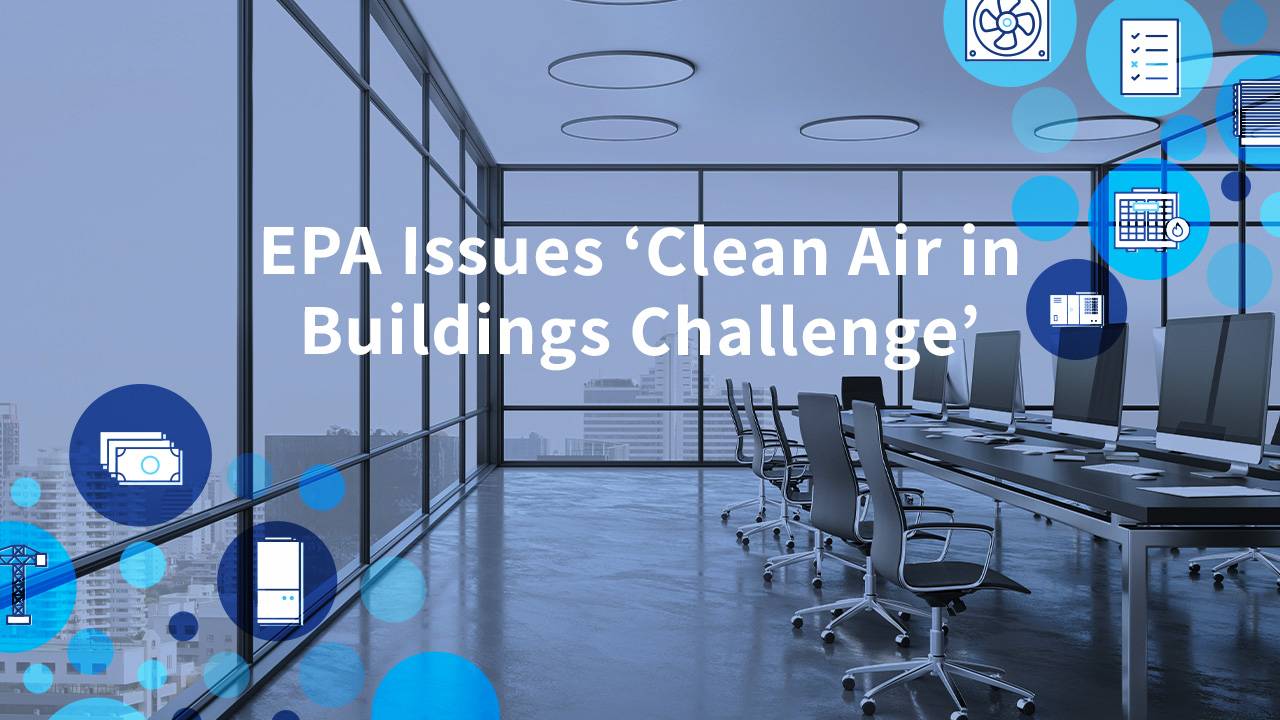As infectious diseases like COVID-19 spread through the inhalation of airborne particles and aerosols, indoor air quality remains a priority in strategies to thwart the novel coronavirus behind the multi-year pandemic. It’s no wonder, then, why the U.S. Environmental Protection Agency encourages layered prevention strategies and other actions to improve IAQ and reduce building occupants’ risk of exposure to aerosols, particles and other airborne contaminants.
Of course, no single action can completely eliminate the risk of COVID-19 and other airborne contaminants, so the EPA recommends a combination of actions best suited to a building’s space and location. To promote property owners’ adoption of an IAQ action plan, the EPA has announced its Clean Air in Buildings Challenge. In conjunction with President Biden’s National COVID-19 Preparedness Plan, the challenge is a call to action for property owners, as well guidance to assist them in reducing the risk of airborne viruses and indoor contaminants.
The Clean Air in Buildings Challenge features a variety of recommendations and resources to assist property owners with improving their IAQ and ventilation, actions that also reduce the risk of spreading COVID-19. Through the challenge, American Rescue Plan and Bipartisan Infrastructure Law funds can be used to help supplement investments made in ventilation and IAQ improvements within public settings.
“Protecting our public health means improving our indoor air quality. Today, EPA is following through on President Biden’s plan to move our nation forward in a healthy, sustainable way as we fight COVID-19,” EPA Administrator Michael S. Regan said in a press release. “Throughout the pandemic, building managers and facility staff have been on the frontlines implementing approaches to protect and improve indoor air quality to reduce risks and keep their occupants safe and healthy, and we are so grateful for their efforts. The Clean Air in Buildings Challenge is an important part of helping us all to breathe easier.”
What does the EPA’s Clean Air in Buildings Challenge include? The challenge features best practices and recommended actions for better indoor air quality and ventilation, including:
Create an IAQ Action Plan
The EPA’s Clean Air in Buildings Challenge encourages property owners to create an action plan for clean indoor air in their buildings. The plan should help assess the current IAQ, plan for improvements and focus on HVAC inspections and maintenance.
Other action plan items include:
- Determine how clean outdoor air is brought into and distributed throughout the building.
- Work with an HVAC expert to assess and inspect systems for optimized ventilation, filtration and air cleaning.
- Determine the amount of clean air that is needed for each room or space and verify the measurements.
- Create an IAQ action plan including regular inspections and HVAC preventative maintenance.
Optimize Fresh Air Ventilation
As part of its Clean Air in Buildings Challenge, the EPA also recommends improving IAQ in buildings by focusing on fresh air ventilation. This can be achieved by bringing in and circulating clean outdoor air on the inside of a building. The EPA’s guidance recommends accomplishing this in the following ways:
- Ensure outdoor air is acceptably cleaned, or it is adequately filtered before bringing it inside the building.
- Run HVAC systems during all occupied hours, ensuring that clean air enters and gets distributed around the building.
- Ensure bathroom exhaust fans are working and running during occupied hours.
- At times of higher IAQ risk, such as times of elevated COVID-19 risk, increase the volume of clean outdoor air that is brought into a building.
- Open windows as often as safety, weather and air quality permit.
Enhance Air Filtration and Cleaning
Another part of the Clean Air in Buildings Challenge guidance suggests property owners enhance air filtration and cleaning by employing their central HVAC system and in-room air-cleaning devices. The EPA suggests owners and operators achieve better air filtration through the following best practices:
- Install the right size of MERV-13 air filters or the highest rated MERV filters that the HVAC system can accommodate.
- Seal leaks and close gaps around air filters to minimize the air moving around them instead of through them.
- Try using portable air cleaners in areas where airflow or central filtration is not sufficient to achieve optimal IAQ.
- Increase both the ventilation and air filtration of areas prone to higher emission of airborne particles and aerosols.
- Try tools like upper-room ultraviolet germicidal irradiation systems to clean the indoor air.
Engage the Community
Of course, no plan can be successful without participation from the surrounding community. The EPA also offers guidance for getting a building’s community engaged in the action, including advice for communicating with building occupants to increase their awareness of and commitment to plans for improving IAQ. Some of the EPA’s community engagement suggestions include:
- Communicate with building occupants, letting them know how the action plan will improve IAQ and reduce disease transmission.
- Showcase improvements by hosting building walkthroughs, posting descriptive signage, or communicating via social media.
- Provide means for occupants to provide their own feedback such as maintenance requests and gather community perspectives through tools like surveys.
- Communicate how individual actions help to optimize IAQ efforts in the building and reduce the spread of COVID-19.












